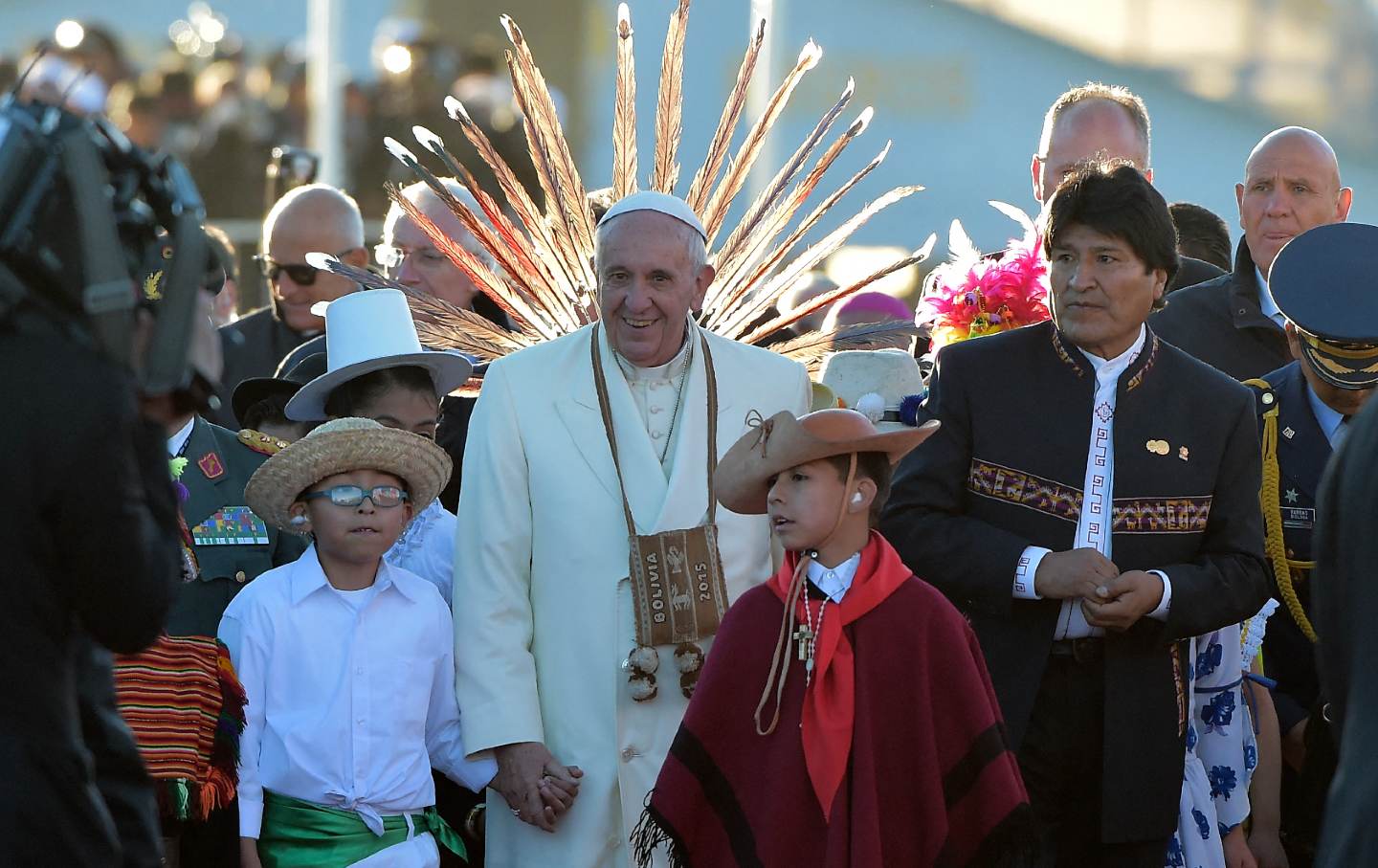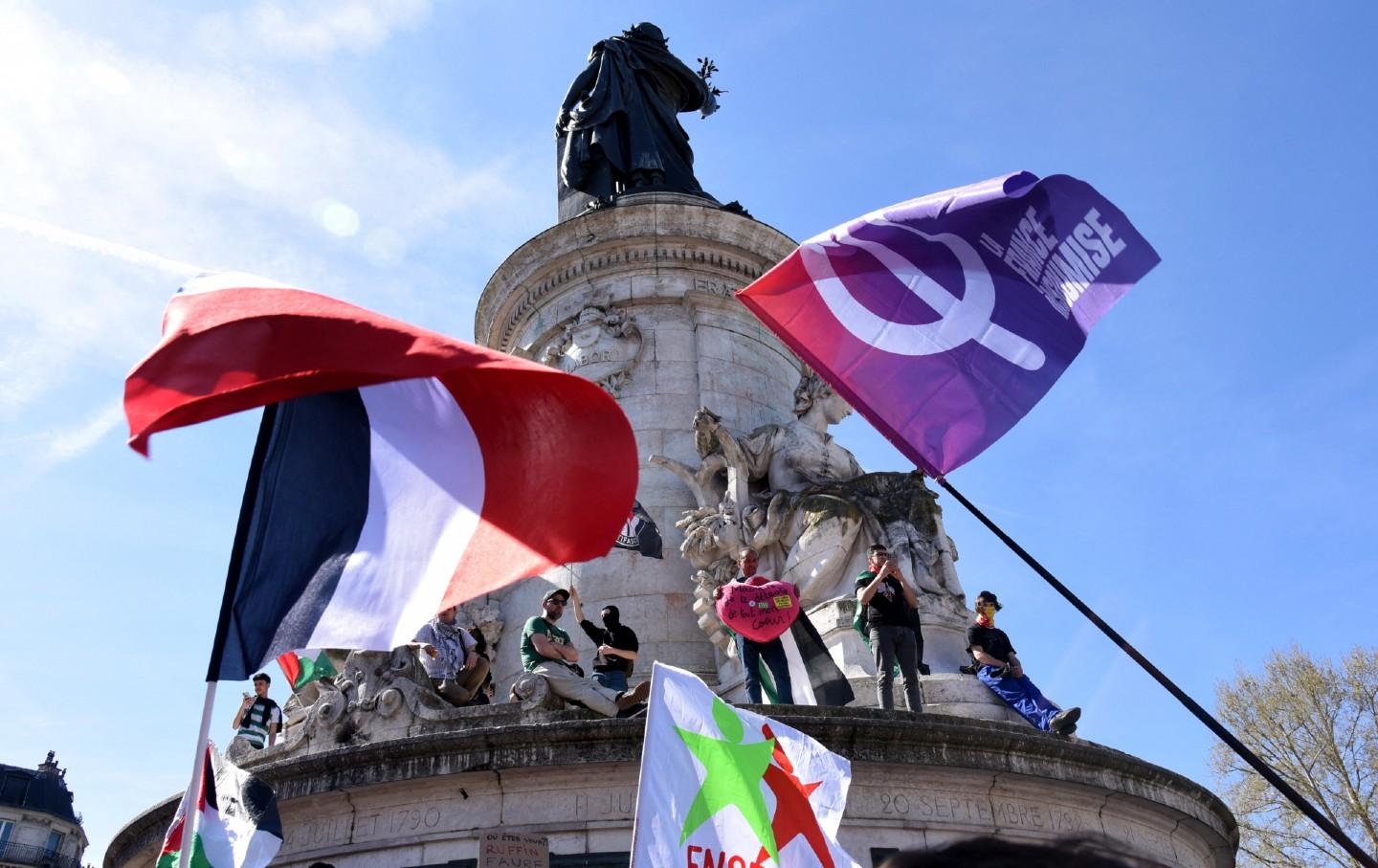The Human Factor
What caused the Irish famine?
What Caused the Irish Famine?
A new book offers a comprehensive and heartbreaking account of the most terrible catastrophe to befall Ireland in the modern era.

Old Chapel Lane, Skibbereen, County Cork in 1846.
(Getty)
The premise of Rot, Padraic S. Scanlan’s comprehensive, elegantly written, and heartbreaking account of what was surely the most terrible catastrophe to befall Ireland in the modern era, is succinctly expressed in a passage from the book’s epilogue: “The structures that built and justified British imperial power in Ireland meant that in 1845”—the first year of the Great Famine—“the leaders of the United Kingdom could find no other way to explain the worst subsistence crisis in the new country’s short history than a definitive lack of civilisation among the Irish. The empire could conceive of no other useful tools to meet the crisis than the principles of the free market and the workhouse.”
Books in review
Rot: An Imperial History of the Irish Famine
Buy this bookIt was Catholic Ireland’s misfortune—one of her misfortunes, in the middle of the 19th century—to be shackled to Britain, an imperialist nation with a flourishing economy founded on the Protestant ethic and a laissez-faire liberalism that saw the rest of the world as a possible colony, market, or both and almost always to blame for whatever economic malady it suffered. The Irish poor, according to many English commentators of the day, had come to depend for sustenance almost exclusively on the potato out of an incurable and slothful barbarism. If these people were starving, it was because they insisted on clinging to their medieval ways and stubbornly refused to modernize.
The United Kingdom, comprising England, Scotland, Wales, and (since 1801) Ireland, was a unit forged—the word is not inapt—by coercion and violence but also by means of legislation, and chief among its laws were the laws of commerce, “which are,” Edmund Burke wrote, “the laws of nature, and, consequently the laws of God.” This declaration, quoted by Scanlan, neatly encapsulates the British conviction that capitalism was a heaven-sent but sturdily earthbound social philosophy that fostered hard work and enterprise and guaranteed prosperity, contentment, health, and strength for those willing to put their backs into it. This apparently did not include the landless Irish “paupers,” who in their “obliviousness to the ‘real’ power of markets to improve,” ended up hungry. “To be civilized meant to live within the social order made by British capitalism, to survive its challenges, and to embrace its virtues.”
Often famines and crop failures are wrongly understood in naturalistic terms, as not man-made but occurring by an act of nature or of God. But when one looks more closely, there is always a human factor involved. This was the case in Ireland.
In the lean years after the Napoleonic Wars, more and more Irish-grown food, mainly grain and livestock, was shipped out of the country, and consequently more and more Irish land was given over to tillage. Soon, the subsistence farming that had relied on varied agricultural produce gave way to the cultivation of a single crop: the potato, which flourishes even in confined areas and in poor soil. By the middle decades of the 19th century, it had come to be depended on as the staple diet for Irish farming and tenant families. Then, in 1844 or 1845, the blight struck. Its cause was Phytophthora infestans, “a fungus-like water mould,” Scanlan writes, which “probably arrived in Europe [from America] in a shipment of seed potatoes unloaded in Belgium.”
The potato blight did not only affect Ireland; it caused widespread crop failures and famine in Europe, from Sweden all the way down to northern Spain, and many thousands of the poor in a number of European countries starved to death. However, no people were as heavily dependent on the potato as the Irish. Scanlan starkly figures the inevitable disaster:
Between 1845 and 1851, at least 1 million people died of famine-related causes. At least 1.5 million more left Ireland as emigrants to Britain, North America, Australia, and elsewhere. The 1841 UK census counted about 8.2 million people in Ireland; ten years later, as the famine was coming to an end, there were about 6.5 million.
The blight pathogen destroyed the potato crop, reducing the vegetable to an inedible mess, “but the famine—a complex ecological, economic, logistical, and political disaster—was,” Scanlan insists, “a consequence of colonialism.”
However, it is important not to be misled into laying the blame for the widespread starvation and resultant deaths exclusively upon the rulers and administrators of the British Empire. The publisher’s jacket blurb, printed in blood-red capitals, speaks of Scanlan’s book as “SHOWING HOW THE BRITISH EMPIRE CAUSED IRELAND’S MOST INFAMOUS DISASTER.” While his name clearly indicates his Irish antecedents, Scanlan is no hot-eyed nationalist bent on naming and shaming the guilty ones among the “bloody brutal Sassenachs,” as the ferociously nationalist Citizen has it in the Cyclops episode of Ulysses. Scanlan’s critical sensibility is much too finely tuned for him to be guilty of such sensationalism. Instead, he seeks to offer a more dialectical and complex story of human errors. In the opening pages of his book, he states flatly: “There was no plan [by the British] to destroy the potato crop, and successive Conservative and Whig governments spent millions of pounds on famine relief.”
Rot, despite its terrible subject, is fascinating in the intricacy of the path it follows, or makes, through the complexities of mid-19th-century relations between Ireland and “the mainland”—a designation that no native-born Irish man or woman would dream of applying to our nearest, more substantial island neighbor. Ireland’s historic rebelliousness—or tiresome intransigence, as some would have characterized it—was starkly manifest, yet again, in the 1798 Rebellion, a popular uprising that took its inspiration from the French Revolution.
The armed démarche was led mainly by the United Irishmen, an oath-bound society founded in Belfast and composed mainly of northern Irish Presbyterians—a fact that in subsequent centuries tended to be glossed over by Irish Catholic educators north and south—and though it failed in its aims, it finally broke the patience of Ireland’s overlords in London. The Irish Parliament was abolished, and at midnight on January 1, 1801, Ireland was formally incorporated with Britain into a United Kingdom.
This momentous shift was presented to the Irish as a boon. After all, how could a small, backward country such as Ireland not benefit from being drawn into a partnership—on supposedly equal terms—with the greatest empire the world had known since the decline and fall of the Roman Empire? Consider alone the worldwide market that Irish manufacturers, traders, and farmers would have direct access to henceforth.
“In reality,” Scanlan writes, “the Irish poor needed relief from the market, not relief through the market.” Social, agricultural, and rental structures in Ireland were such that the Irish simply could not compete in open, international trade. The country had not a fraction of the natural resources, especially coal, that drove the Industrial Revolution and made Britain—made England—one of the most prosperous nations on earth, and turned it into a military and naval power against which not even Napoleon could prevail.
British officialdom, although there were some honorable exceptions within it, regarded the “Irish question”—by which was really meant the “Irish problem”—with deepening incomprehension, impatience, and exasperation. Why could they over there not be more like us over here?
As the century approached its midpoint, many in Britain began to suspect that the Irish were exaggerating their predicament and putting on what in Irish is known as the béal bocht, the “poor mouth,” with a hand ever extended “because,” as one observer insinuated, “they hope to get some of England’s bounty, and to escape paying their rent.”
Yes, almost the entire potato crop had failed; yes, the people were dying in their cabins, on the highways, in the fields; yes, entire families were being thrown upon the roadside as evictions multiplied; yes, the “coffin ships” were filled to the gunwales with emigrants desperate to find a haven in Britain, America, Australia. But as Scanlan reports:
Even at the peak of the famine, British officials kept the faith—market competition was always considered better than direct aid from the government or other institutions. Laissez-faire economic policies were a lot of work. Government officials were anxious to create conditions within Irish rural society that would lead the Irish to behave “naturally,” as political economy predicted.
British authorities regarded Ireland’s misfortunes as evidence of the country’s incurable and willful medievalism; indeed, the famine was seen in almost biblical terms as a pestilence sent down by a vengeful God upon a sinful and slothful people. But as Scanlan is at pains to point out, the famine was in fact the result of forces within high capitalism that were entirely modern. “Although it appeared wholly ‘natural’ and spontaneous,” he writes, “the late-blight pandemic was an unintended consequence of the increasing integration of global commerce.”
All over the world, vast new territories were being opened to cultivation and exploitation, and larger and faster ships plied back and forth over the oceans, ferrying all varieties of foods to feed Europe’s and the New World’s burgeoning populations. This created a new era, a new global age in which, as Scanlan writes, “fertiliser mined by indentured Chinese contract labourers on arid islands off the coast of Peru—islands that had been visited for millennia by seabirds, which deposited phosphate-rich guano in layers many metres deep”—was soon allowing “farmers across North America and Europe to increase yields. Farms separated by oceans became ecological neighbours.”
Looking at the situation from this perspective, one can see it is no wonder that crop diseases propagated so vigorously and so widely. As Scanlan notes, the blight might have been caused by “even just one blighted potato or preserved spore that then cloned itself by the quadrillions.”
The catastrophe was sudden, and irresistible. There was not a slow depletion of food supplies but an abrupt cessation. When the potato crop failed, the Irish poor had nothing, literally nothing, to eat. To its credit, the British government, led by the Conservative Party prime minister, Robert Peel, took cognizance of the crisis and acted relatively swiftly by setting up the Irish Relief Commission, which would begin its operations in May 1846.
The commission purchased £185,000 worth of maize—or “Indian corn,” as the Irish called it—from America, for sale and distribution to the increasingly desperate populace. However, maize, a tough, bright-yellow grain, was difficult to cook and even more difficult to digest by a people raised on potatoes, so that it became known among the Irish as “Peel’s brimstone.” Still, efforts at alleviation were made—certainly the authorities did not stand idly by, as some Irish histories claim.
Popular
“swipe left below to view more authors”Swipe →However, compassion was tempered by practical motives. Relief, Scanlan writes, “was an argument for the Union” between Britain and Ireland and “offered a chance to prove the superiority both of free trade over protection and of British management of Irish affairs.” Politics, of course, had its ugly head permanently reared. Successive British governments were distracted by ongoing controversy over the proposed abolition of the Corn Laws, an issue that would eventually bring about the fall of Peel’s administration and its replacement by the Whig Party, led by Lord John Russell. The latter, a person of diminutive stature, had married, in 1835, a widow named Adelaide Lister, whose husband, Baron Ribblesdale, had died a decade prior; after the wedding, parliamentary wits nicknamed Russell “the Widow’s Mite.” His contribution to solving the Irish crisis was commensurate with his physical stature.
In the Irish folk memory, the chief villain of the famine years was, and in some quarters still is, the British Treasury official Charles Trevelyan, whose task it was to implement the government’s relief program in Ireland. Scanlan, however, is scrupulously even-handed in his treatment of this “skilled bureaucrat whose faith in liberal political economy and laissez-faire, individual discipline and prudence was consistent with his devout Protestantism and faith in the ‘natural’ laws of the market.” Yet while Trevelyan may have been a skilled bureaucrat, one must also note his inexcusable condescension. In his 1848 memoir The Irish Crisis, he had described the famine, Scanlan tells us, as the “sharp but effectual remedy” by which Irish backwardness would be cured at last.
The problem was not just capitalism but imperialism as well. As a young man, Trevelyan had worked in the British civil service in India and consequently, Scanlan notes, “saw Ireland through a colonial lens, as an alien, uncivilised Celtic fringe of the United Kingdom.” To Trevelyan’s cold bureaucratic eye, the Irish probably seemed not quite real, or so underdeveloped as to be somewhat less than human. However, he did his best, according to his lights, and was certainly not beyond displaying sympathy for the thousands who were suffering and dying. In a letter at the time, quoted by Scanlan, Trevelyan wrote that whatever might be the cost in money and effort, “the people must not, under any circumstances, be allowed to starve.” All the same, he never once visited Ireland during the famine years.
By 1847—“Black ‘47,” as the Irish call it—starvation was at its worst. In February, the House of Commons in London passed the Temporary Relief of Destitute Persons (Ireland) Act, under which relief committees were set up to run soup kitchens “so that labouring men should be allowed to work on their own plot of ground, or for the farmers, and thus tend to produce food.” Self-help was still the order of the day.
News of Ireland’s distress had now reached the wider world, and voluntary donations poured in from abroad. Queen Victoria led the way, with a donation of £2,000. Money came from the most diverse sources, including not only such stalwarts as the East India Company and the Bank of England, but also the Ottoman Sultan Abdulmejid I, the crew of the HMS Hibernia, the officers of London’s Metropolitan Police, slave workers in Alabama, who raised $50, and the Choctaw Nation, which, Scanlan writes, “donated $710, roughly $20,440 in today’s money.”
One of the more bizarre figures in Rot is Alexis Soyer, head chef at the Reform Club, a haven for gentlemen on Pall Mall in London. With the encouragement of Trevelyan and other officials, Soyer established a model soup kitchen in Dublin, on a tract of land known as the Croppies’ Acre, hard by the banks of the River Liffey. His kitchen was some 2,000 square feet in size, and there were tables and benches to seat 100 diners; “in front of each place was an enamelled iron soup bowl, with a spoon attached by a chain to the rim.” Afterwards, Soyer claimed to have served 1.14 million bowls of soup between March and July 1847. Some Dubliners, however, were less than appreciative. Zozimus, a famed street singer and balladeer, wrote a song that ended with the line “My curse on such imposters and bould Sawyer and his soup.”
In the epilogue of Rot, Scanlan writes of the Great Exhibition of the Works and Industry of All Nations, which opened in London’s Hyde Park on May 1, 1851. By then, the famine in Ireland was coming to an end, but the recollections of the horrors the people had suffered over the previous six years were still fresh (as was the consequent bitterness and rancor felt by the Irish). The central feature of the exhibition was the Crystal Palace, “a glass and iron greenhouse three times the size of St. Paul’s Cathedral.” Needless to say, Ireland and her troubles figured less than prominently in this grand display of the wonders of the age—“Irish exhibitors presented their wares as part of the United Kingdom’s delegation, organised by industry”—yet the famine was, as Scanlan writes, “a disease of modernity,” in which
the Irish starved because the idea of the free market and the industrious and individual worker was so deeply entrenched in British politics and political economy as to be effectively inviolable, even in the deepest crisis.
That is, business as usual.
Hold the powerful to account by supporting The Nation
The chaos and cruelty of the Trump administration reaches new lows each week.
Trump’s catastrophic “Liberation Day” has wreaked havoc on the world economy and set up yet another constitutional crisis at home. Plainclothes officers continue to abduct university students off the streets. So-called “enemy aliens” are flown abroad to a mega prison against the orders of the courts. And Signalgate promises to be the first of many incompetence scandals that expose the brutal violence at the core of the American empire.
At a time when elite universities, powerful law firms, and influential media outlets are capitulating to Trump’s intimidation, The Nation is more determined than ever before to hold the powerful to account.
In just the last month, we’ve published reporting on how Trump outsources his mass deportation agenda to other countries, exposed the administration’s appeal to obscure laws to carry out its repressive agenda, and amplified the voices of brave student activists targeted by universities.
We also continue to tell the stories of those who fight back against Trump and Musk, whether on the streets in growing protest movements, in town halls across the country, or in critical state elections—like Wisconsin’s recent state Supreme Court race—that provide a model for resisting Trumpism and prove that Musk can’t buy our democracy.
This is the journalism that matters in 2025. But we can’t do this without you. As a reader-supported publication, we rely on the support of generous donors. Please, help make our essential independent journalism possible with a donation today.
In solidarity,
The Editors
The Nation








